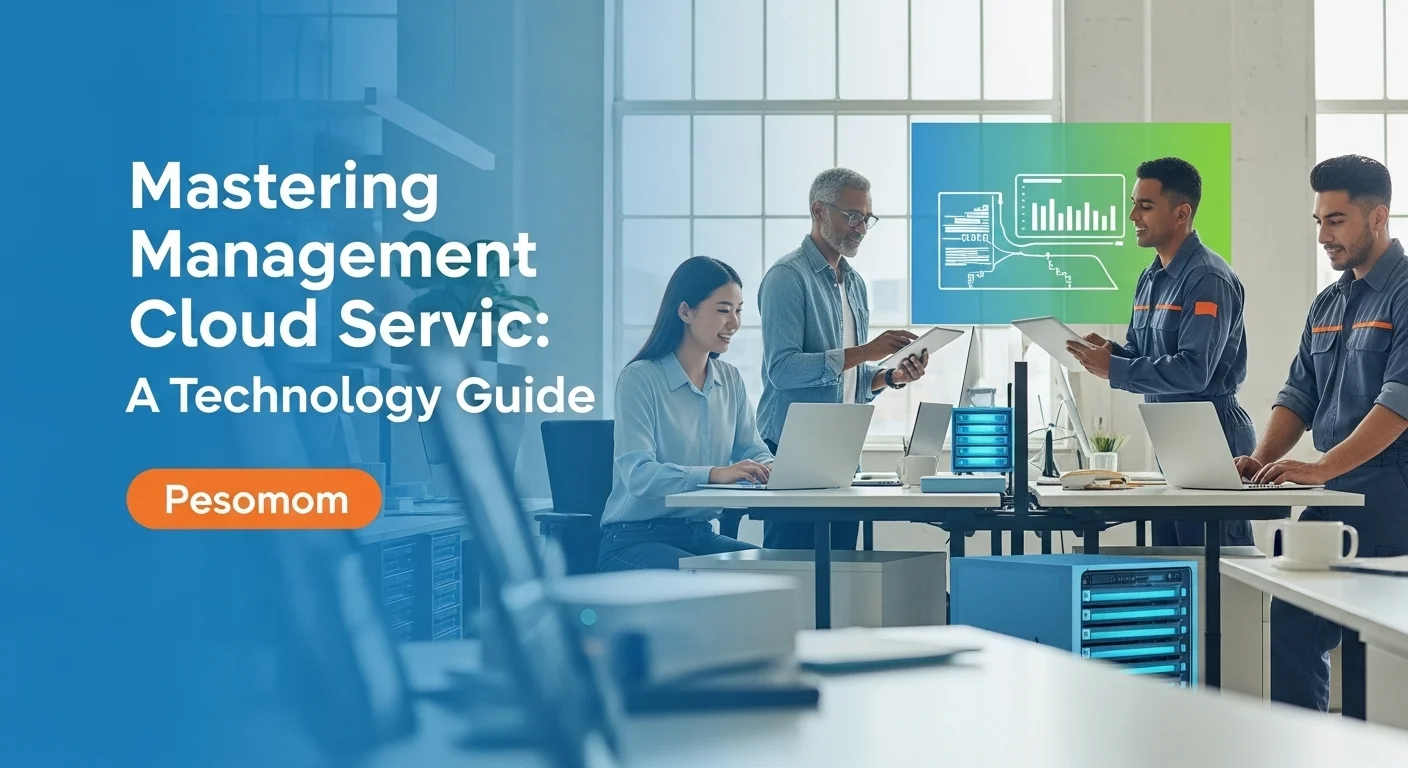Cloud Management Services: A Practical Guide for Your Business

Executive Summary
In today's digital world, moving to the cloud isn't just a tech upgrade—it's a core business strategy. But let's be honest, this shift can create a real headache when it comes to managing all your scattered resources, keeping data secure, and preventing costs from spiraling out of control. This is where Cloud Management Services come in. Think of it as the command center for your entire cloud operation. It's a full suite of solutions, from third-party experts who handle the daily grind (managed services) to structured processes that keep everything running smoothly (service management). A key piece of this puzzle is making sure the right people have the right access, which is where identity management comes in. For any business or tech pro, getting a handle on these services is the key to unlocking the cloud's true power. It lets you slash overhead, tighten security, and get back to focusing on what you do best: growing your business. This guide is my attempt to break it all down for you, based on years of helping companies navigate this exact journey.
Table of Contents
Table of Contents
What Are Cloud Management Services and Why Do They Matter?
In the world of tech, we love our buzzwords, but 'Cloud Management Services' is one that truly matters. In simple terms, it's the collection of tools, strategies, and expert help you need to control, fine-tune, and secure your cloud environment. I've seen firsthand how a brilliant cloud strategy can fall apart without good management. It's like having a fleet of high-performance cars without any drivers, mechanics, or security. The importance of this can't be overstated. Without a solid management plan, the cloud's promises of cost savings and agility can quickly turn into runaway bills, security nightmares, and operational chaos. In this first part, we'll get to the heart of what cloud management really is and why it's non-negotiable for any business that relies on technology.
Deconstructing Cloud Management: The Three Core Pillars
To really get what cloud management is all about, it helps to break it down into three main pillars. These aren't separate ideas; they work together to create a complete strategy. Each one solves a specific set of problems, and when they're combined, they give you the power to run your business effectively and securely in the cloud. These pillars are: managed cloud services, service management, and the crucial security layer of identity management as a service (IDaaS).
1. Understanding Managed Cloud Services
Let's start with the most hands-on part: managed cloud services. This is where you outsource the heavy lifting of your cloud operations to a third-party expert, known as a Managed Service Provider (MSP). Instead of trying to build and manage a large, expensive in-house team of cloud specialists, you can tap into the expertise of an MSP. I often recommend this to businesses that want to focus on their product, not on network configurations. An MSP can handle everything from migrating you to the cloud, setting up your infrastructure, and providing 24/7 monitoring, to managing security and optimizing costs. The beauty of this model is its flexibility—you can have them manage one specific thing, like your databases, or your entire multi-cloud setup. This shifts your IT costs from large, upfront hardware purchases to a predictable monthly operational expense. The real win is gaining access to world-class expertise that ensures your cloud is not just running, but running optimally.
2. The Strategic Framework: Service Management in the Cloud
If managed services are the 'hands-on' work, then service management is the strategic 'playbook'. This concept takes the proven principles of IT Service Management (ITSM), which many of us know from frameworks like ITIL, and applies them to the dynamic world of the cloud. It’s a structured approach that looks at the entire life of a cloud service, from idea to retirement, to make sure it aligns with your business goals. It breaks down like this:
- Strategy: Figuring out which cloud services you actually need to support the business.
- Design: Architecting those services to be reliable, scalable, and secure.
- Transition: Building, testing, and rolling out new services without causing chaos.
- Operation: The day-to-day work of fixing issues, handling user requests, and keeping the lights on. This is where a good service management process proves its worth every single day.
- Continual Improvement: The cloud is always changing. This phase is about using data to find ways to make things better, faster, or cheaper.
Implementing a solid service management framework turns your cloud use from a simple tech project into a powerful business strategy.
3. The Security Cornerstone: Identity Management as a Service (IDaaS)
You can't talk about cloud management without putting security front and center. The absolute foundation of cloud security is controlling who can access what. This is the job of Identity Management as a Service (IDaaS). In the old days, we had one central directory to manage users. Now, your team might need access to dozens of different cloud apps. Managing logins for each one is a recipe for disaster. IDaaS platforms solve this by offering:
- Single Sign-On (SSO): One password to access everything. Users love it, and it's much more secure.
- Multi-Factor Authentication (MFA): A crucial extra layer of security, like a code from your phone, that stops criminals even if they steal a password.
- Automated Provisioning: When someone joins your company, they automatically get the access they need. When they leave, all access is cut off instantly, closing a major security hole.
- Centralized Control: Admins can manage all access rules from one dashboard, ensuring no one has more access than they absolutely need to do their job.
By making IDaaS part of your strategy, you build a strong security foundation to protect your most important digital assets.
The Importance and Business Benefits of a Cohesive Strategy
Bringing these three pillars together isn't just a technical exercise; it's a game-changer for the business. First, it leads to real cost savings. With proper management, you can stop paying for resources you aren't using and prevent surprise bills. Second, it dramatically improves your security and helps you meet compliance rules like GDPR or HIPAA. Third, it makes your team more efficient. By automating routine tasks and relying on expert MSPs, your internal team can finally focus on projects that drive innovation. And finally, it makes your business more resilient. A well-managed cloud can scale with demand and recover from problems quickly, keeping your business running no matter what. In the end, cloud management is what transforms the cloud from a simple utility into your most powerful strategic asset.

A Complete Guide to Implementing Cloud Management Solutions
Now that we've covered the 'what' and 'why' of cloud management, let's get into the 'how.' This part of the guide is all about putting theory into practice. I'll walk you through the technical tools, business tactics, and resources you can use to build a cloud management strategy that actually works. A successful cloud journey is a mix of the right technology, the right processes, and, more often than not, the right partners. We'll compare different options and I’ll give you some actionable advice for choosing and implementing solutions, making sure that your use of managed services, service management principles, and IDaaS security delivers real results for your business.
Technical Methods, Platforms, and Frameworks
The core of great cloud management is the tech you use to monitor, automate, and control your environment. There's a whole market of tools out there, from the ones built by cloud providers themselves to powerful third-party platforms.
1. Cloud Management Platforms (CMPs) vs. Native Tools
CMPs are software suites that give you a single dashboard to manage everything across different clouds (like AWS, Azure, and Google Cloud) and even your own data centers. Think of them as a universal remote for your entire hybrid cloud. They're fantastic for large companies juggling a complex setup. However, if your business is mostly on one cloud provider, their built-in 'native' tools are incredibly powerful and often cheaper. For example:
- AWS: Has a whole ecosystem of tools like Systems Manager for operations, CloudFormation for coding your infrastructure, and Control Tower for governance.
- Microsoft Azure: Offers Azure Arc, which lets you manage infrastructure anywhere as if it were in Azure. Azure Monitor and Azure Policy are key for service management.
- Google Cloud: Provides its Operations Suite for monitoring and Anthos for managing apps across different clouds.
My advice? If you're all-in on one cloud, master its native tools. If you're balancing multiple providers, a CMP can be a lifesaver.
2. Automation, Orchestration, and Infrastructure as Code (IaC)
In the cloud, doing things manually is a path to failure. It's slow, invites errors, and simply doesn't scale. Modern cloud management is built on automation. A key practice here is Infrastructure as Code (IaC), where you define your entire setup (servers, networks, databases) in code files. Tools like Terraform or AWS CloudFormation let you build and tear down environments in minutes, repeatably and reliably. This isn't just a tech-nerd thing; it's a core part of effective service management. For configuring the software itself, tools like Ansible or Puppet ensure every server is set up exactly the same way, every time. Orchestration tools, most famously Kubernetes, take this to the next level by automating how your applications are deployed, scaled, and managed.
3. Monitoring, Observability, and ITSM Integration
You can't manage what you can't measure. The goal today is 'observability'—not just tracking metrics you already know, but being able to dig in and understand unexpected problems. Tools like Datadog or New Relic provide this deep visibility. A critical step I always push for is integrating these monitoring tools with an IT Service Management (ITSM) platform like ServiceNow or Jira. This way, when a problem is detected, an incident ticket is automatically created, tracked, and sent to the right person, all according to the service management rules you've set.
Business Techniques for Selecting the Right Services
Picking the right tech is only half the story. Choosing the right partners is a huge business decision that can make or break your cloud strategy.
1. How to Choose a Managed Cloud Services Provider
Selecting an MSP is about finding a strategic partner. Here’s the checklist I give my clients:
- Proven Expertise: Do they have the official certifications for the cloud platforms you use? This isn't just paper; it's proof of their skill.
- The SLA Matters: The Service Level Agreement is your contract. It must clearly define uptime guarantees, response times, and what happens if they fail to meet them. Read the fine print.
- Security and Compliance Focus: Ask them tough questions about their security practices and their experience with compliance standards in your industry, like HIPAA or PCI DSS.
- Transparency: A good partner doesn't operate in a black box. They should provide clear reports on performance and costs and be willing to work collaboratively with your team.
- Check Their References: Talk to their current customers. Hearing about their real-world experience is the best indicator of what you can expect.
2. Implementing Identity Management as a Service (IDaaS)
Choosing and rolling out an IDaaS platform like Okta or Microsoft Entra ID is a major security project. Here’s a simple, methodical way to approach it:
- Discovery: First, map out every application and user you have. You need to know what you're trying to protect.
- Vendor Selection: Compare providers based on how well they integrate with your apps, their security features, and their pricing.
- Pilot Program: Always start small. Test it with a low-risk group of users to iron out the kinks.
- Phased Rollout: Gradually move everyone over. This is also the perfect time to clean up old accounts and permissions.
- Train Your People: Show your employees how the new login process works, especially MFA. A smooth transition depends on good communication.
By putting a solid IDaaS in place, you create the foundation for a Zero Trust security model—where nothing is trusted by default and everyone has to verify who they are, every time.
Forging a Unified Strategy
The most successful companies don't just pick one of these components; they weave them together. Your service management framework sets the rules. Your managed services provider is the expert team that executes them. And your IDaaS solution secures the front door for everyone. When this system works in harmony, it’s incredibly powerful. It's how you turn a complex technological mess into a streamlined, secure, and powerful asset for your business.

Advanced Tips and Strategies to Master Your Cloud Experience
Once you have the basics in place, it's time to take your cloud operations to the next level. This final section is about moving from simply 'managing' your cloud to truly 'mastering' it. The goal is continuous improvement across costs, security, and performance. I'll share some advanced strategies, essential tools, and my thoughts on future trends that are already shaping the world of cloud management. By adopting these practices, you can turn your cloud environment from a necessary expense into a major competitive advantage, ensuring you get the absolute most out of your technology investment. This means mastering advanced techniques in managed services, refining your service management processes, and hardening the security provided by your IDaaS platform.
Advanced Best Practices for Cloud Management Maturity
To really stand out, your organization needs to build a culture of constant refinement and adopt some next-level operational models.
1. Mastering FinOps: The Art of Cloud Financial Management
One of the biggest shocks for companies moving to the cloud is cost control. FinOps is a discipline that brings financial discipline to the flexible spending model of the cloud. I think of it as common-sense financial hygiene for your tech. Key FinOps strategies include:
- See Where the Money is Going: Implement a strict 'tagging' policy for every cloud resource. This lets you assign costs to specific projects or departments. It's about accountability.
- Stop Wasting Money: Constantly look for waste. This means downsizing oversized servers ('right-sizing'), deleting storage that isn't attached to anything, and moving old data to cheaper storage.
- Commit and Save: For your steady, predictable workloads, use things like Reserved Instances or Savings Plans. You commit to using a certain amount of computing for one or three years, and in return, you can get discounts of over 70%. It requires some forecasting, but the savings are huge.
2. Enhancing Security with a Zero Trust Architecture
The old idea of a secure network 'perimeter' is dead in the cloud. A Zero Trust model assumes no one is trustworthy by default, whether they're inside or outside your network. Everyone has to prove their identity to access anything. Your IDaaS platform is the engine for this strategy. To take it further:
- Lock Down Privileged Access: For your admins and other high-level users, use Privileged Access Management (PAM) tools. These systems grant elevated permissions only for a specific task and for a limited time, and they log everything.
- Automate Your Security Checks: Use tools that constantly scan your cloud for misconfigurations, like a publicly exposed database. They can automatically fix common issues, preventing breaches before they ever happen.
- Regularly Review Who Has Access to What: Set up automated quarterly reviews where managers have to re-approve their team's access rights. This ensures that permissions don't bloat over time.
3. Building Resilience with AIOps and Proactive Planning
Mature cloud operations are proactive, not reactive. AIOps (AI for IT Operations) uses artificial intelligence to analyze performance data, spot potential failures before they happen, and even trigger automated fixes. This is the future of service management. Of course, you still need a rock-solid Disaster Recovery plan. This means regularly testing your backups, using multiple geographic regions for critical apps, and being confident you can recover from an outage quickly.
Essential Business Tools and Real-World Experiences
To make all this happen, you need great tools and sometimes, great partners. For companies that want to outsource this complexity, working with top-tier managed cloud services providers like Rackspace, Cognizant, or Accenture is a popular route. They bring their own platforms and deep expertise to the table. A great resource for vetting these partners is the Gartner Magic Quadrant for Public Cloud IT Transformation Services.
Let me share a quick story. I worked with a mid-sized e-commerce company that was plagued by crashes during big sales events, and their cloud bill was completely out of control. They tackled it with a three-part strategy. First, they brought in an MSP to re-architect their platform for high availability and provide 24/7 monitoring. Second, they implemented ServiceNow to formalize their service management processes for incidents and changes. Third, they secured their remote workforce and developer access with Okta as their IDaaS solution. Within a year, they hit 99.99% uptime, cut their cloud spending by 25% through FinOps practices, and closed major security gaps. It was a powerful demonstration of how these pieces work together.
Future Trends and Final Thoughts
Cloud management is always evolving. Here’s what I'm keeping an eye on:
- Serverless Management: As more apps are built on platforms like AWS Lambda, we'll need new tools to monitor, secure, and manage costs for these tiny, event-driven functions.
- Edge Computing: As the cloud extends to millions of IoT and edge devices, managing and securing them will be the next great challenge.
- Sustainability (GreenOps): There's a growing focus on the environmental impact of the cloud. GreenOps is emerging as a discipline focused on optimizing for energy efficiency and a lower carbon footprint.
In the end, cloud management isn't a project with a finish line; it's a continuous journey. By combining expert managed services, strategic service management, and robust IDaaS security, you can build a cloud foundation that is resilient, secure, and cost-effective. The strategies I've shared here are a roadmap to maturing your cloud practice, ensuring your technology doesn't just support your business today, but fuels its innovation for tomorrow.
Expert Reviews & Testimonials
Sarah Johnson, Business Owner ⭐⭐⭐
This was a good overview, but as a small business owner, I'd love to see a section on how these strategies apply to a smaller budget. More practical, step-by-step examples for non-tech founders would be a huge plus.
Mike Chen, IT Consultant ⭐⭐⭐⭐
A solid guide that connects the dots between managed services, ITSM, and IDaaS. I'm an IT consultant, and it gave me a great framework for explaining these concepts to my clients. The section on choosing an MSP was particularly helpful.
Emma Davis, Tech Expert ⭐⭐⭐⭐⭐
Fantastic and thorough article! As a cloud engineer, I appreciated the depth on AIOps and Zero Trust. It's rare to find a guide that covers both the strategic framework and the advanced, forward-looking tech so clearly. I've already shared it with my team.



